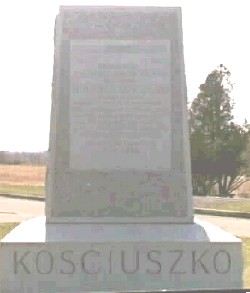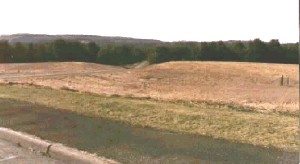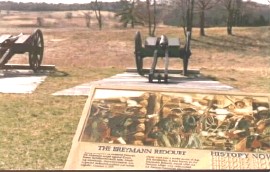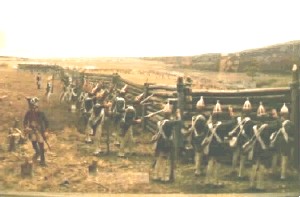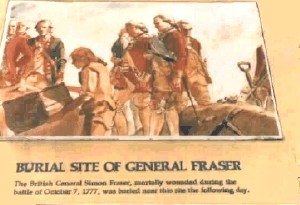|
Battles of Saratoga Freeman's Farm and Saratoga September-October, 1777 The Battles of Saratoga marked the turning point in the war of the north. It was after this victory, that France decided to lend its support to the fledgling War of Revolution. The battles of Saratoga may be viewed as two different battles: The Battle of Freeman's Farm (also known as First Saratoga), and Saratoga. Or one, long running battle, beginning in mid-September and culminating October 17, 1777. The British strategy was a pincer campaign to control the important Mohawk Valley, the commerce center of Albany, and isolate New England from New York and Philadelphia. The British General John Burgoyne (affectionately called "Gentleman Johnny" by his soldiers), led a force of 8000 down the northern New York frontier from Canada, accompanied by 1000 camp followers of Indians and soldier's wives. In support of Burgoyne's efforts was Lt. Col. Barry St. Leger with some 1600 Regulars and Indians, who traveled east through the Mohawk Valley and ambushed General Nicholas Herkimer at the battle of Fort Schuyler, August 4-22. Benedict Arnold led a relief column and joined Herkimer in the battles of Fort Stanwix, August 4-22, and Oriskany, August 6-22. Arnold's aggressive tactics routed St. Leger who was forced to retreat back to Montreal. The British plan, authored by Burgoyne, called for a third force to travel north from New York City under General Sir William Howe, commander-in-chief of British forces in America. The three pronged assault would isolate and capture Albany. With St. Leger's retreat, the plan was damaged but not severely crippled because the main forces could still close in from the north and the south. General Howe had not received any specific instructions about the Burgoyne plan and therefore, directed his attention toward Washington's army in New Jersey and the American capital city of Philadelphia. He left General Sir Henry Clinton in command in New York. On September 21, Burgoyne heard from Clinton that he was about to make a diversion up the Hudson. He sent a dispatch to Clinton on September 27 asking for orders but an answer was never received. Clinton started with a small force on October 3 and captured two forts on the west bank, but he never had any intention of penetrating to Albany.
On July 6th, Burgoyne had captured the Northern outpost of Fort Ticonderoga, forcing
the withdrawal of 2,300 Americans. He continued south, pushing his way toward the southern tip of Lake George with little combat resistance but the progress was slow. General Philip Schuyler, [father-in-law of Alexander Hamilton] despite being forced to retreat from overwhelming numbers, rushed a force of 1000 woodsman into the forest to fell trees, burn bridges, and place other obstacles in Burgoyne's path. The British column, burdened by wagons for the women, extra supplies, bridge building, swamps, and other natural barriers was slowed to a crawl. The British column was limited to little more than a mile per day. The slow pace created a shortage of supplies and by August 16, Burgoyne found it necessary to dispatch a raiding party to search for food.
The raiding party, made up of both Brunswick soldiers and German troops (Hessians), headed toward Bennington, an area known to have many loyalist. However, on August 16th, as the party neared Bennington, it was met by the Green Mountain militia, under John Stark and severely defeated at Hoosic Falls.
Chronology of events leading to Burgoyne's surrender.
General Schuyler had sent the Polish engineer Thaddeus Kosciuszko to find a suitable position to engage the British near Saratoga. Washington, upon hearing of the British advance, began furnishing reinforcement troops to Schuyler. One unit was commanded by Brig. Gen. Benedict Arnold who helped Kosciuszko lay out the American defensive position at Bemis Heights. Also, Daniel Morgan from Virginia supplied 500 of his crack rifle troops. Although General Schuyler had the situation under control, Congress pressured Washington into sending Maj. Gen. Horatio Gates to Saratoga to take command. Gates had an abrasive personality and an arrogant attitude. Soon he and Arnold were in conflict. In fact, few officers who came in contact with Gates got along with him. There were problems in the ranks also, between the New York and New England soldiers. On September 13, 1777 Burgoyne crossed the Hudson from the east bank toward Saratoga, but stopped 4 days later, settling near Bemis Heights. The colonist had harassed his troops, and his numbers had been reduced to about 6000 (he had left 1000 in garrison at Ticonderoga). Additionally, Gates had superior intelligence about the British, thanks in part to Schuyler's delaying tactics which provided the Americans ample opportunities for scouting. However, Burgoyne had the support of loyalist and he was aware of the reinforcements and the overall situation. He felt that he only needed to bide his time until General Clinton arrived. Burgoyne sent out three columns to "develop the situation" and on September 19 the battle of Freeman's Farm (first Saratoga) erupted.
As the fighting progressed, Gates believed that he should maintain his position and engage the enemy as they advanced, but Arnold was of the opinion that the Americans should take the battle to the British. Arnold, who had a numerically superior force, therefore took an "active defense" and attacked at Bemis Heights. Daniel Morgan and his crack Virginia riflemen, violating the rules of war of that day, specifically targeted the British officers, and sent the advanced column reeling in full retreat. The Virginians, quick to follow up on this success, formed a disorganized charge, putting them face to face with the main body of the advanced column. The British troops with superior discipline and experience, sent the Virginians back into the forest for cover. American light infantry then engaged the British, and for 3-4 hours the heaviest part of the battle occurred. General Riedesel, the Hessian commander, had taken the rear guard with a reduced force to protect Burgoyne's supplies and artillery at a position near the Hudson River. Soon he learned that a general engagement was underway at Freeman's Farm, and at about 5:00 P.M., sent support to the farm. In order to remove the Americans threatening Burgoyne's center column, Reidesel used his German regulars to thwart the Americans, and Burgoyne slowly gained back lost ground. Gates could have destroyed Burgoyne's supply depot near the river and ended the conflict, but he failed to capitalize on this position. Meanwhile, Arnold had not prevailed at Bemis Heights and returned to obtain reinforcements. Gates relieved him of command. With Arnold removed from battle, Burgoyne effectively held the ground, but paid a terrible price... 350 dead or wounded out of 800 who had engaged in the fighting.
Burgoyne wanted to follow up the next day, September 20th, but General Simon Fraser who had fought with the light infantry and grenadiers convinced him that a day's rest would be best. Furthermore Burgoyne was informed that Clinton was on his way up the Hudson from New York City. Knowing that he would soon have the Americans surrounded, Burgoyne decided to construct defensive field fortifications. He built the Balcarres redoubt at Freeman's Farm, the forward most position, as well as the Breymann Redoubt. His Canadian troops began constructing stockaded cabins, a floating bridge across the Hudson River, as well as many other defensive earthworks. Meanwhile, American militia under General Benjamin Lincoln was disrupting the lines of communication behind Burgoyne from Saratoga to Lake Champlain. Also, militia from surrounding areas reinforced Gates position on Bemis Heights, as well as increased military supplies under the direction of General Schuyler.
As the days passed, Burgoyne was beset with problems. In the hot sweltering summer heat, illness and desertion were taking their toll, and his horses were starving. By October 3rd, things were so bad that troops were reduced to 1/3 rations. The Americans harassed British foraging parties and a state of constant readiness was necessary in the British camps. Reidesel had suggested withdrawal, reestablishing communications with Canada, and await Clinton's arrival, but Burgoyne would have no part of it. He was determined to march on Albany. Unable to collect any solid intelligence, on October 7th Burgoyne sent out another reconnaissance party, with the hope of mounting an attack on Bemis Heights. Burgoyne did not know that Clinton had decided against a march up the Hudson River.
Gates had used the British delay to construct a series of defensive earthworks. Gates then ordered Daniel Morgan's troops to "begin the game", with Morgans' troops attacking one flank of the British lines while Gen. Enoch Poors' troops attacked the other. Burgoyne used a company of 600 Rangers to screen the right flank, while the main column of 1500 regulars marched southwest to a high ground they had noted during the previous battle. Poors' brigade held their position against the highly trained grenadiers of Maj. John Acland, despite a valiant bayonet charge mounted by the grenadiers. The New Hampshire troops overran the British position and captured it. Morgan's Riflemen in the meantime had been attacking the opposite flank and the rear. Henry Dearborns's Light Infantry met the charging British line, and the threat to the right flank was ended. A British officer, who had an order of withdrawal, was mortally wounded. The German center line, unaware of the withdrawal order, fought on. Benedict Arnold, although relieved of command, entered himself into the battle and mounted a charge. Arnold forced the British to withdraw and pressed the battle to prevent retreat into fortifications. As the withdrawal became more widespread, the British bypassed their redoubts, thus giving up the field. Arnold then led an unsuccessful attack against the troops still in the Balcarres redoubt. He fell back, gathered fresh troops and cleared a line between Balcarres and the Breymann redoubts. He then led an attack against the Breymann redoubt but it was a costly assualt: He was wounded in the leg and crippled for life. [This injury later led Washington to assign Arnold to less vigorous duty. Arnold then made contact with the British and began selling information, see Benedict Arnold and West Point.]
During the battle Arnold had noticed a British officer in the center of the British line, rallying the troops in the face of the American advance. He relayed this information to Daniel Morgan, who in turn had one of his riflemen terminate the man; British General Simon Fraser. Burgoyne, with very few options, made a forced withdrawal to the Great Redoubt, and then withdrew to Schuylerville. Gates was in no position to follow-up, but on October 12th he had the British surrounded and Burgoyne surrendered. Gates gave generous terms of surrender because he still feared an attack from Clinton from the south. The Convention of Saratoga was consummated on October 17th and Burgoyne's troops were paroled, "upon the condition of not serving again in North America during the present contest."
Burgoyne, although embarrassed, forever denied that he surrendered. He claimed that the conflict ended with a cessation of fire, citing similar terms ending the Seven Years War.
|
All rights reserved. For details and contact information: See License Agreement, Copyright Notice. |

